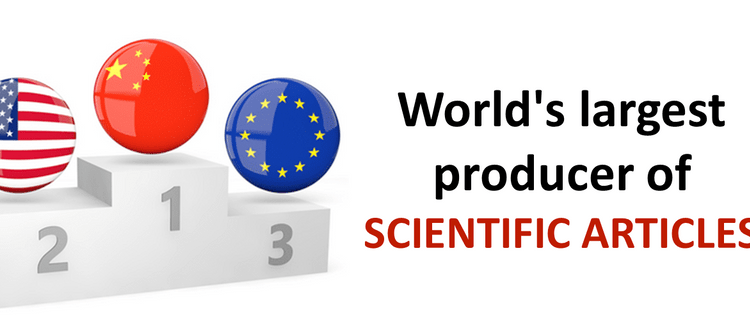China Overtakes U.S. With The Highest Number of Scientific Publications

Image credits: Flag icons via Freeflagicons
China’s progress has been remarkable in the field of science and research. The recent reports released by the U.S. National Science Foundation (NSF) proves this fact even more. According to the reports released, China has produced the largest number of scientific publications in the year 2017. While doing so, it has left behind nations like the United States and European Union.
China Has Published More Scientific Articles than US
In three decades, China has moved from third in the world for producing scientific research articles to the first position, surpassing both the European Union and the United States. China’s growing economy along with the new government’s focus on science has played a major role in this new development. The Chinese government has brought about several changes for China’s progress in science. Among the changes brought about by the government, payment for publication made to the scientist needs special mention. It is an approach not even used in the EU or U.S. The new approach to publication has helped to net a 3,000% increase in the number of scientific publications, and the numbers are expected to rise.
Through the last part of the nineteenth and into the early years of the twentieth-century countries like Italy, Great Britain and Germany topped the lists for the most research and related publications. The United States took the lead in the early twentieth-century and remained on top for more than ninety years. China began to gain ground by the mid-1990s. In 2016, China published more than 426,000 studies, which covers 18.6% of the total documented in Elsevier’s Scopus database. On the other hand, nearly 409,000 studies were published by the United States.
China’s Move to a Paid-to-Publish Format
For the science researcher, the payment for publication is often unmade and in some instances looked down upon. In the field of academia, private research as well as industry, most scientists produce research and the related publication as part of their primary contract. Academic and research publications pay nothing for their articles, and the peer-review system frequently means they get the best articles from the discipline. Without remuneration for publication, the primary reward to the researcher is in the publication itself, seeing your name associated with the work through a byline. For academics on a tenure-track, there is further incentive through the tenure and rank advancement process, but nothing that would necessarily stimulate publications well above the minimum set by the institution.
China was the first major industrialized nation to recognize that additional rewards would help in the production of more publications. Implementing a system where researchers are paid to publish their work in appropriate journals, China began to gain on both the EU and the U.S. In 2017, China passed the United States in the number of science publications having produced at least 15% more articles each year for the last two decades.
Most of the paid publications by the Chinese government are for internal journals. However, there has been a steady increase in the number of outside journals where researchers now publish. In the last two decades publication in Chinese journals has dropped from over 40% to now just over 20% of the total number of papers being published.
Chinese Authorities Working to Renew Ethics to Publishing
In recent years, ethical issues in the academic community have been investigated to help control the quality of publications in China. Since 2015 the Chinese government has been actively investigating fraud and ethical claims, with many of those coming through the China Association for Science and Technology (CAST) in Beijing. Two recent CAST investigations have focused on the Chinese “paper broker” industry. A paper broker is responsible for securing publication for a researcher, and in unethical terms. This often means the use of fraudulent sources or review processes. At least two-dozen articles from leading journals were found to have been tainted during the review process in just the first few months of the investigation. Over the last five years, this number has increased by quite many folds.
Last March, China’s Ministry of Science and Technology had carried out a survey. According to their investigation, they found more than 100 papers were retracted by foreign medical journals. All of these papers were alleged of peer review fraud. The ministry announced a “zero tolerance” policy towards academic fraud. It also announced severe penalties for authors found guilty. In fact, a few months before the Tumor Biology journal, published by Springer, had announced the retraction of 107 papers from Chinese authors. The journal believed the peer review process was compromised.
Bright Future of China’s Science
Scientific research needs funding. In 2015, United States had spent the most on research and development (R&D)—around 500 billion USD. China came in second, with roughly 400 billion USD spent on research. However, with the U.S. economy in trouble, expenditure on research continues to remain flat. On the contrary, China has increased its R&D spending, proportionally, in recent years. All these have resulted in the current position of China in international science. By no means would the Chinese researchers abandon the method. With impressive increases in both the number of publications internally and internationally, the Chinese system has raised expectations and outcomes. With the new guidelines and policies being put in place there will be more focus on preventing the unethical or illegal behavior. This, in turn, will result in a positive outcome for both China and the world.
What do you think researchers from other nations need to learn from China’s progress in the field of science and research? Please let us know your thoughts in the comments section below.










What counts is not the raw number of publications but what is done with the reported research. I just presented a paper reporting that the “publish or perish” syndrome in the U.S. served to isolate U.S. academia from real world society. When peer reviewed publications became prime credentials for promotion and tenure in the 1960s this set in motion an internal competition among academic faculty. The demands of that system no longer encouraged or allowed faculty to produce applied research of importance to society. Their energies were directed toward peer-reviewed research and publication in specialized media. Even Intradepartmental cooperation declined in favor of cooperation with colleagues who shared interests, no matter how far away these people were geographically.
Social scientists took data from public activities but circulated their publications among themselves. They were neither designed to be useful to decisionmakers or the literate public, and were not used by them. The result was devastating for U.S. society. Universities in effect took a key talent pool and locked it up in an ivory tower where it only communicated internally through specialized disciplinary publications. It also affected training of students as though they would become future professors in academia, themselves.
Finland took an opposite approach to that which emerged in the U.S. Finnish universities, especially technical universities tended to encourage public spirited attitudes on the part of faculty. That meant focusing significant attention on products and developments useful for the larger public, and exposing students to real-world enterprises and activities during their schooling.
We now have the greatest fragmentation in society since the Civil War. This is a trend that was similarly fostered by universities, that offered an almost unlimited opportunity for fields of concentration. There were minimal mandatory core courses that would foster a degree of common knowledge.